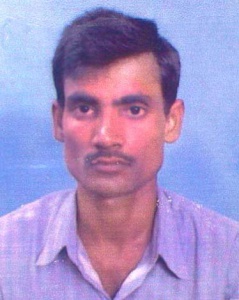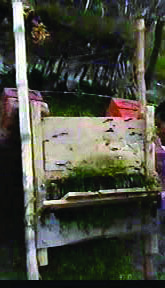Name : Chandrapal Singh
District & State : Basti, Uttar Pradesh
Category : Utility
Award : Consolation
Award Function : 3rd National Grassroots Innovation Awards
Award Year : 2005
Innovation Description
Chandrapal Singh (32) is an innovative farmer who hails from Dofda, Basti in Uttar Pradesh. He did his Bachelor of Arts from Shiv Harsh Kisan College, Basti. After passing out of college in 1995, he has been doing farming. For sometime, he tried to operate a mini rice mill, but had to give it up due to financial difficulties. In his spare time, he reads books on science, ayurveda, general knowledge, religion, etc. He also spends a lot of time in observing new machines to figure out how they work and studying the problems that farmers face in carrying out agricultural activities. He has developed an idea for a fodder cutter which has greater capacity, consumes less energy and cuts fodder with great accuracy, thus proving to be a boon for farmers especially in rural areas.
 Genesis Being a farmer himself, Chandrapal Singh closely observed and used existing machines to process fodder. He noticed that the problem with such machines is that fodder has to be fed in these machines in small quantities. Some farmers operate it by hand, others use a motor. So long as the blade is sharp, it is easy to cut fodder, but as the blade turns blunt it becomes more and more difficult and the cut fodder is also spoilt. The problem with the motor-powered device is that of feeding it with raw material. Its capacity is limited and there is a great danger of the person feeding it, cutting his hands. Also the blade becomes blunt quite often and it has to be sharpened again and again. Because of this most farmers prefer to use hand-operated chaff cutters.
Genesis Being a farmer himself, Chandrapal Singh closely observed and used existing machines to process fodder. He noticed that the problem with such machines is that fodder has to be fed in these machines in small quantities. Some farmers operate it by hand, others use a motor. So long as the blade is sharp, it is easy to cut fodder, but as the blade turns blunt it becomes more and more difficult and the cut fodder is also spoilt. The problem with the motor-powered device is that of feeding it with raw material. Its capacity is limited and there is a great danger of the person feeding it, cutting his hands. Also the blade becomes blunt quite often and it has to be sharpened again and again. Because of this most farmers prefer to use hand-operated chaff cutters.
When serrated sickles came into fashion, Chandrapal began thinking that if the blade is replaced by a serrated blade, then the problem of frequent sharpening could be solved. But there was a problem here. The normal blade cuts by exerting pressure, where as with a serrated blade one cuts by sawing.
He thought about making a new type of fodder cutter in 1997 when the wheat straw got wet in the rain. As it was wet, the stalk twined around the axle of the chaff cutter. Even when very small quantities of straw were used, the engine stalled. Around this time he saw a cutter which had 100 axles. It had a very high capacity and was fitted with stoppers in the form of strips that were welded to it. He estimated that if the number of axles were increased, the output may also increase. Then he thought that it might be possible to make these axles from circular plates of metal. By fitting these plates to a shaft, it may be possible to make thousands of axles. Since these axles are also very thin, the output may be high.
He experimented by applying a pulley and varying its rpm and pressure. He noticed that along with increasing the rpm if the size of the meshing is also increased, then the output increases. This happens because when the rotation is fast, the stalk of wheat breaks, whereas when it is less the stalk twines around the shaft. He also noticed that as long as the axle of the device has a core, the output is good, but once the core gets worn out, the output rapidly falls. He also observed that the thinner the axle, the higher the output. Also when the size of the straw is large, the output is high.
He figured out that if the wheat straw was kept parallel to the plates and if the stoppers are fitted between the axles, then it would be more convenient to operate the device and thus the idea of a new fodder cutter was developed.
Advantages
In existing machines the fodder has to be fed in small bundles and care has to be taken that the quantity inserted is not too much or too little. If the quantity is too much, the machine is not able to process the excess fodder and ejects it as it is, or sometimes even stalls. If this happens the straw has to be manually pushed inside the machine, and while doing this there is possibility of injury to the hand. Where as in this modified machine the bundles are simply placed on the feeding platform and there is no need to handle the straw manually. Therefore it is much safer to operate. In existing machines after running for sometime, the blades become blunt and have to be sharpened again. After running for one hour, the blade has to be taken out and sharpened by an ironsmith. This innovative machine does not require frequent sharpening of the blades. Since the blades are serrated, they last much longer. When the teeth get worn out, new teeth can be cut on the blades. The existing machine has a limited capacity and consumes a lot of power. But the proposed machines may have a high capacity and consume less power. Due to slanted feeding trough for straw in this innovation, automatic feeding may be possible and less man power may be required. Chandra Pal estimates the cost of the model at Rs.5000-6000. He feels that the cost of subsequent machines could be reduced when manufactured in bulk. NIF has sanctioned him a sum of Rs.12,500 from the Micro Venture Innovation Fund for prototype development of the fodder cutter.
Other ideas
Chandrapal Singh is the owner of a mind brimming with ideas. Some of his other innovations are:
Threshing machine
Chandrapal Singh has an idea of modifying the fodder cutter that he has made so that it can function as a thresher, on which if the ears of wheat are placed it will automatically thresh them and separate the grains from the straw. It should have a high capacity, should be able to handle wet straw and should not consume too much power.
Multi-fuel engine
He has another idea for an engine that can run on every type of fuel. According to him such an engine would utilize solid fuels like wood, coal, etc. and help to alleviate the energy crisis to an extent. In this multifuel engine cheaper fuels could be used to generate power and it would be suitable for all types of fuel as compared to existing conventional engines which are different for each kind of fuel. In addition in this novel engine the fuel gets longer time to burn and therefore burns completely, thus it has high efficiency and causes less pollution as compared to the conventional engine in which the fuel does not burn completely as it get less time.
Modified Seed-dibbler
Chandrapal Singh has also developed an idea for a modified seed-dibbler which would not only make holes at several places in the ground simultaneously but also inject seeds into these holes. With this device, the seeds are evenly distributed and are placed at uniform depths into the soil. Therefore, fewer amounts of seeds are required for sowing and the germination level is also high. This would be especially useful in intensive agriculture which is necessary to meet the increasing demands of a rising population.
Innovative Idea
The device consists of about 100 discs which are mounted on a 1.5 to 2 m long shaft. Each disc is a plate with a diameter of about two feet and is circular in shape. There is an aperture in the middle and on the edges there are facilities for fixing the blades. These blades are serrated and about six to eight blades are fixed on each disc. The thickness of the plate is about two mm. After placing the blades all around the disc, a ring is placed over them and then fixed with bolts. Another option is to make the serrated edge on the edge of the disc itself. To keep the discs with the serrated blades separate, small rings are placed on the shaft between the discs. This distance depends on the size of the straw and the size of the cut fodder that is desired. There is an advantage in keeping the blades separate. When they become blunt or worn-out, they can be easily replaced. The shaft should be very firmly fixed to the bearing to reduce friction and other damages. The blades used should be of a high quality so that wear and tear is minimal.
Functioning
The fodder bundles would be fed to the machine parallel to the shaft. There is a slanting trough on which the fodder bundle can be kept. The straw that has to be cut is kept on the slanting trough and as the shaft rotates, it is drawn in and cut. Due to the slope the straw will move down on its own. If the straw is very long, the uncut part can be fed again to the machine. To rotate the shaft at high speed it is connected to an engine or a motor. There are several ways to control the cutting rate and load. One method is to vary the rpm of the machine. Another way is to place several semicircular discs between the cutting discs and then move them as per requirement. The stopping strips fixed to separate the cut straw from the discs should be fitted in a slanting position so that the cut straw moves away from the cutting blades. If the stopping strips touch the rotating discs, they can damage the blades and create unwanted noise as the machine operates. Since the machine has a very high output, very soon the cut fodder accumulates before it. A vacuum fan could be used to remove the cut fodder. Wet fodder cannot be blown away very far with a fan, but wet fodder is usually cut only in small quantities every day. The machine can also be placed at height so that there is space below for the cut fodder to accumulate.
Usually farmers possess few animals and therefore, there is a need to develop cheaper machines. For this the diameter and the number of the discs used can be reduced. Discs could be one foot in diameter or even less.
